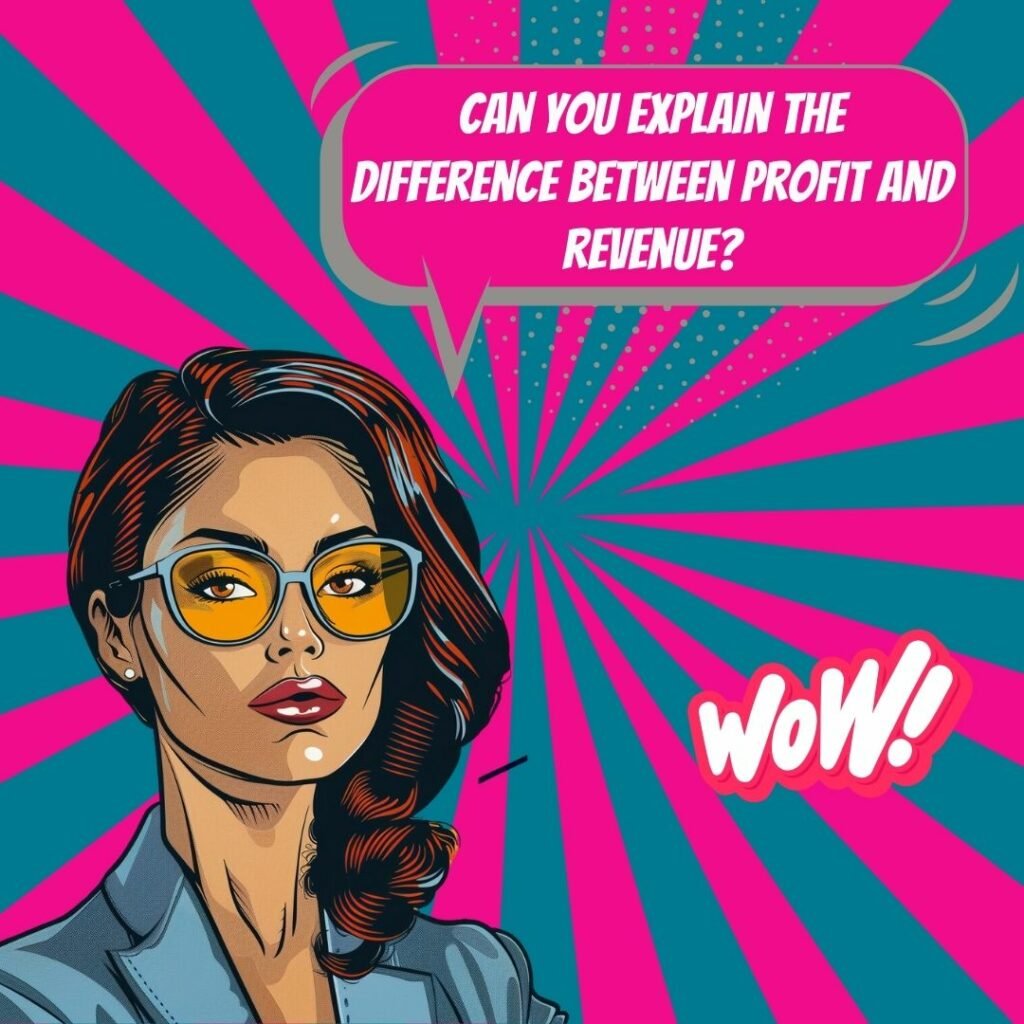Key Takeaways
✅ Profit vs. Revenue: While revenue is the income from sales or services, profit is what’s left after expenses. Statistically, a business can have sky-high sales yet minimal profit—or moderate sales with substantial profit. Actions to consider: Evaluate your expense structure to ensure you’re not just boosting sales but real profits.
✅ The Profit Cap: By definition, company profit cannot be larger than total revenue—after all, you can’t keep more than you’ve earned, right? But that doesn’t stop some businesses from making every penny count. Tip: Focus on maximizing each sale’s value and minimizing unnecessary costs.
✅ Accounting Confusions: Different accounting styles can paint different pictures. For example, with cash-basis accounting, revenue appears when money changes hands. On the other hand, accrual accounting counts earnings when they’re made, not received. Both can shape how we see profit in relation to revenue. Remember: Consistency in your accounting method provides clarity.

Introduction
Can profit ever race ahead of revenue? It’s like asking if a sprinter can finish a race before it starts—seems impossible, right? But hold on. There’s more to this story. Let’s set the scene: business owners, entrepreneurs, and the financially curious, you’ve likely heard the age-old rule—expenses must be lower than sales to ensure profit. But here’s where it gets interesting. We’re diving deep into the crux of financial success—profitability.
This article isn’t just a routine examination of numbers; it’s about shattering illusions and confronting the complexities of profitability. Have you ever wondered why some businesses seem to have the Midas touch, turning modest sales into significant profits, while others struggle to keep the lights on despite booming sales? Join us as we unwrap this enigma. We’re not just talking profits and revenue; we’re unlocking new ways to think about your bottom line. And yes, this involves some unconventional wisdom. Can savvy strategies and astute financial planning actually twist the familiar tale of earnings and sales? Let’s unearth the hidden truths together.
We promise to load you up with actionable insights and groundbreaking information that could very well tilt the scales of financial understanding in your favor. Stick around – your journey to optimizing your company’s profitability starts now!
Top Statistics
| Statistic | Insight |
|---|---|
| Profit Margin Misconception: Profit cannot exceed revenue; it’s the amount remaining after expenses. | Knowing this helps bust common myths and sets a clear foundation for financial comprehension. |
| Profit Margin Trends: S&P 500 companies had an average net profit margin of 11.9% in 2020. | These figures reflect how sector differences significantly influence profit margins, with some sectors outperforming others. |
| User Demographics and Profitability: Nike saw a net profit margin of 13.4% in 2020, with Millennials and Gen Z forming 75% of its customer base. | Demonstrates the impact of targeting younger audiences, who can drive profit margins up due to their consumer behavior. |
| Industry Forecasts: E-commerce market to reach $6.54 trillion by 2022 with a growth rate of 14.7% annually. | Implies an enormous potential for companies in e-commerce to amplify their profitability by leveraging market growth. |
| ESG Factors: Firms with high ESG ratings tend to have higher profitability, averaging a profit margin of 10.7%. | Highlights that ethical operations and social responsibility aren’t just good practice; they’re also good for the bottom line. |
Understanding Profit and Revenue
Ever sit down and really think about profit and revenue? They’re not just fancy business terms – they’re the nuts and bolts of business survival. See, revenue? That’s the total cash your business pulls in from selling goods or services. Imagine a lemonade stand; every quarter you get for a cup of lemonade is revenue. Now, profit is what you’ve got left after paying all the grown-up expenses – like lemons, sugar, and those little paper cups. It’s the actual money you pocket. If you’ve made more money than you’ve spent, that’s your profit. So, to keep things super simple: profit equals revenue minus expenses. That’s Business 101, right there.
The Myth of Profit vs. Revenue
Now onto a head-scratcher – can profit actually outdo revenue? Many would say “Hey, that doesn’t make sense!” But let’s pause for a second. The mix-up happens because people usually view profit as a chunk of revenue, something that could never be bigger than the whole. However, if we throw in the concept of profit margin, the game changes. This margin is pretty much your financial scorecard; it tells you how much you make from every dollar of sales, after all the bills are paid.
Profit Margin and its Impact
Let’s delve deeper into profit margin. It’s basically your financial grade in percentages. High school nostalgia, anyone? If your lemonade stand has a profit margin of 30%, you’re keeping 30 cents from each dollar in sales. But here comes the twist – we’re not talking about absolute dollar values, we’re talking ratios. So, when you hear about profit exceeding revenue, it’s not about raw numbers; it’s about percentage points. A one-off event, like selling a piece of equipment or getting an insurance payout, could technically inflate profit temporarily—not a sustainable method, but it does put the math puzzle pieces together.
Real-World Examples
Let’s leave the lemonade stands behind and look at some actual companies. Yeah, there are real businesses out there with profit figures soaring high above their revenue numbers. Take businesses with low running costs but high returns on certain transactions, or ones that sold a piece of the company and recorded it as profit. Or consider tech companies with minimal overhead but highly lucrative patents or software licenses. Their magic potion for surging profits? Cost-cutting, savvy pricing strategies, and sometimes, a stroke of good luck with a big-time asset sale.
Importance of Profitability
Now, why’s everybody obsessed with profit? Because it’s the lifeblood of any business – that’s why. Long-term success? It hangs on profitability. Without profit, a business is like a car without gas – not going anywhere fast. Managing expenses and making smart moves is crucial. Being thrifty without being stingy, knowing where to invest and where to hold back – that’s the tightrope walk of business strategy that can lead to a stellar profit margin. It’s not just about making money; it’s about keeping it, too.
AI Marketing Engineers Recommendation
Recommendation 1: Understand the Difference Between Revenue and Profit: Before diving into strategizing, it’s crucial to grasp the basics. Revenue is the total amount of income generated by the sale of goods or services related to the company’s primary operations. Profit, on the other hand, is what remains after all expenses are subtracted from the revenue. Asking whether profit can exceed revenue is like asking if you can save more money than what you earn in a month – it’s not mathematically possible, as profit is derived from revenue. However, you can maximize your profit by increasing revenue and decreasing costs. Use current data to identify which products or services generate the most revenue with the least cost, and optimize accordingly.
Recommendation 2: Leverage Data Analytics for Cost Optimization: Now, think about your expenses. Sometimes, hope lies in trimming the fat. Can you cut down on any overheads without compromising on quality or customer experience? Analytics can be your best pal here. Dive into your cost structure with tools like Google Analytics or Tableau, which can illuminate wasteful spendings. By integrating financial data and analytics, current trends suggest businesses can identify inefficiencies and reduce costs, effectively boosting their profits while maintaining or even increasing revenue.
Recommendation 3: Enhance Value Proposition to Increase Revenue: Flip the coin and look at revenue – it’s not just about slashing costs, it’s about upping the game, too. What can you offer that others don’t? Can you add a new feature, or maybe provide exceptional customer service? Consider using customer relationship management (CRM) tools like Salesforce or HubSpot to track customer behaviors and preferences, delivering personalized experiences that could lead to higher sales and, in turn, revenues. When your value stands out, not only does revenue increase, but you also lay a foundation for sustainable profitability.
Relevant Links
Maximize Your Affiliate Revenue: 2024 Guide to Skyrocketing Profit
Your Roadmap to Affiliate Wealth
Choose Wisely: Unlocking the Full Potential of ChatGPT
Free vs Paid ChatGPT: Your Ultimate Guide
Revolutionize Your Content Strategy with AI
ChatGPT Marketing Magic: Crafting Killer Content
Master AI Prompt Engineering for Unmatched Engagement
Prompt Engineering Mastery in Marketing
Small Business Success with ChatGPT: Insider Tips
ChatGPT: Small Business Growth Accelerator
Fresh Business Ideas That Will Boom in 2024!
2024 Small Business Ideas That Shine
Stay Ahead: Top 10 Digital Marketing Trends for 2024
Navigating Future Digital Marketing Waves
Supercharge Google Ads with AI-Generated Creatives
Chat GPT: The Game-Changer for Google Ads
Conclusion
Well, we’ve come quite a way on this journey of numbers and notions, haven’t we? We’ve wrestled with the idea that profit and revenue are two peas in a pod, yet not quite the same thing. And you might still be scratching your head, wondering, can profit really roll in higher than revenue? Remember that profit margin we chatted about? That’s the secret sauce.
Sure, by now, we’ve debunked that old myth that profits can’t overtake revenue. It’s not a common sight in the business world, but, as we saw with those real-world examples, it’s not impossible either. These companies didn’t just luck out; they had a plan. They managed their expenses like champions and made strategic moves that would impress any chess player.
Now, profit exceeding revenue isn’t an everyday occurrence, and it’s not something you should hang your hat on without a little skepticism. But it’s important to understand that aiming for a healthy profit margin isn’t just number-crunching; it’s about the future of your business, its survival, and how it thrives.
So, as we wrap this up, think about this: How are you going to steer your ship? Will you be aiming for those high profit margins with smart choices and savvy spending? Let’s keep this real – it’s not going to be easy street, but the reward could just be your business becoming the next example we talk about when we look at those who’ve made more money in profit than what they first pulled in through sales.
FAQs
Question 1: What is the difference between profit and revenue?
Answer: Revenue refers to the total income generated from sales or services provided by a business. Profit, on the other hand, is the amount of money left after all expenses, including taxes, have been deducted from the revenue.
Question 2: Is it possible for profit to exceed revenue?
Answer: No, profit cannot exceed revenue. Profit is always a smaller amount than revenue because it is calculated after expenses have been deducted.
Question 3: Why is it important to understand the difference between profit and revenue?
Answer: Understanding the difference between profit and revenue is crucial for financial management and decision-making. Revenue represents the sales performance of a business, while profit indicates its overall financial health and ability to generate returns for stakeholders.
Question 4: Can a business have a negative profit but positive revenue?
Answer: Yes, a business can have negative profit but positive revenue. This situation occurs when the expenses exceed the revenue, leading to a loss.
Question 5: What factors contribute to a business’s profitability?
Answer: Factors that contribute to a business’s profitability include efficient cost management, effective pricing strategies, economies of scale, product differentiation, and competitive advantage.
Question 6: How can a business increase its profitability?
Answer: A business can increase its profitability by reducing expenses, optimizing pricing strategies, increasing sales, improving operational efficiency, and investing in innovation and marketing.
Question 7: What is the role of accounting in understanding profit and revenue?
Answer: Accounting plays a crucial role in understanding profit and revenue by providing financial statements, such as the income statement, which shows the revenue, expenses, and profit of a business. Accurate accounting helps businesses make informed decisions and track their financial performance.
Question 8: Can a business have a high revenue but low profit?
Answer: Yes, a business can have a high revenue but low profit. This situation occurs when expenses are high relative to revenue, leading to a smaller profit margin.
Question 9: What is the difference between gross profit and net profit?
Answer: Gross profit is the profit a business makes after deducting the cost of goods sold from revenue. Net profit, on the other hand, is the profit after all expenses, including taxes, have been deducted from the revenue.
Question 10: How can a business maintain a healthy balance between revenue and profit?
Answer: A business can maintain a healthy balance between revenue and profit by regularly reviewing its financial performance, implementing cost-saving measures, optimizing pricing strategies, and investing in areas that drive growth and efficiency.
Academic References
- Weygandt, J. J., Kimmel, P. D., & Kieso, D. E. (2019). Managerial Accounting: Tools for Business Decision-Making (9th ed.). Wiley. This key textbook offers a deep dive into the principles of managerial accounting and clarifies the concept that profit—what’s left after deducting costs—can never outdo the revenue, the sum total of money brought in from sales.
- Hermanson, R. H., Edwards, J. D., & Maher, M. W. (2019). Financial Accounting: A Business Perspective (13th ed.). D.C. Heath and Company. This textbook stands out for underlining that profit, the financial performance marker for a company, is the revenue left after meeting all expenses, reinforcing the fact that revenue is the ceiling that profit cannot break through.
- Watts, R. L., & Zimmerman, J. L. (2019). Accounting: Concepts and Applications (12th ed.). McGraw-Hill Education. The textbook discusses the delicate interplay between revenue, expenses, and profit, asserting that profit is the remainder after costs and inherently cannot surpass the total revenue, all the while stressing the significance of this understanding for truthful financial reporting and smart business choices.













